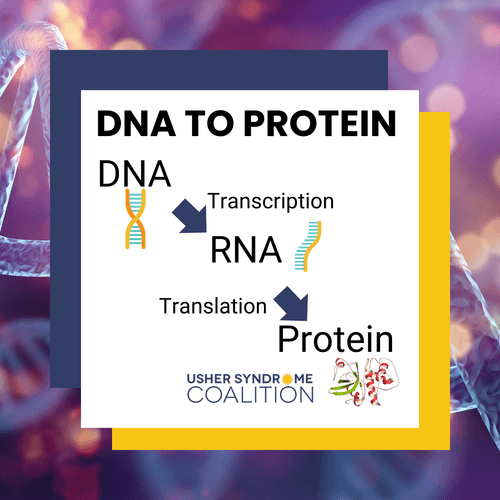Grounded in Science
A balance of research news and well-being for the Usher syndrome community.
Usher Syndrome Awareness Day is September 21st!
September 21, 2024, marks the tenth year of celebrating Usher Syndrome Awareness Day. This special day for our global community is held on the third Saturday of September each year. This is near the autumnal equinox in the northern hemisphere, which marks the beginning of days with more darkness than light, a powerful metaphor for the threat of Usher syndrome. By raising awareness worldwide, we connect those living with Usher syndrome, building a global community that speeds the search for treatments.
We created a new T-shirt design in honor of this day. With each purchase, a portion of the proceeds goes back to the Coalition to help us continue to grow, connect, and support the Usher syndrome community. Snag yours here!
https://www.bonfire.com/usher-syndrome-awareness/
Proclamations for Usher Syndrome Awareness Day
So far, members of our USH community have secured proclamations for 2024 in the following states:
- Illinois
- Nebraska
If you have received a proclamation, please share it with us!
Usher Syndrome Awareness Day Events
Canada:
The CN Tower in Toronto, Canada, will light up blue and gold on September 21, 2024, to raise awareness for Usher syndrome on Usher Syndrome Awareness Day! Lighting begins at sunset and will be fully visible as the sky darkens. Stay tuned for live views on the CN Tower website!
Mexico (Modalidad Virtual): Webinar “Síndrome de Usher: ¿Dónde estamos in Mexico?” | “Usher Syndrome: Where are we standing in Mexico?”
Webinar organizado por asociaciones, especialistas médicos y aliados para conmemorar el día del síndrome de Usher en México, con el fin de proveer información de actualidad a los pacientes y familiares.
[Webinar hosted by organizations, medical specialists and allies to celebrate Usher Syndrome Day in Mexico, with the goal of providing up-to-date information to the Usher patients and families.]
Usher Syndrome Data Collection Program (USH DCP)
Now is a good time to make sure you’re in the USH Trust and USH DCP.
Once you’ve signed up for the USH DCP, make sure to fill out the diagnostic survey! We are trying to get 80 new signups by the end of the month so we can share more data like this:
For additional USH DCP sign-up support please fill out this form.
Have you joined the Usher Syndrome Coalition Discord Community Server? It’s a safe place for the community to connect with each other. Join here: https://discord.gg/czwHGaDu7W
Research Spotlight
The Lived Experiences of Transition-Age Youth with Usher Syndrome Preparing for Postsecondary Education: A Retrospective Study
Dr. Tara Brown-Ogilvie of the Helen Keller National Center recently published her dissertation entitled, “The Lived Experiences of Transition-Age Youth with Usher Syndrome Preparing for Postsecondary Education: A Retrospective Study.”
She conducted interviews and focus groups with 10 college students with Usher syndrome about their transition experiences from high school into college and explored six themes:
- Limited K-12 educational supports for postsecondary preparation
- Perceived lack of transition planning and postsecondary preparation
- Parents as the strongest support system
- Discrepancy in Deaf/Hard of Hearing and vision services (more D/HH than VI)
- The multifaceted impact of USH
- Navigating the medical diagnosis
Additionally, implications for practice from this study include:
- Promoting earlier diagnosis by creating resources and better USH screening processes
- Having a DeafBlind specialist on the educational team
- The importance of an individualized transition plan
- Recognizing that the USH population is evolving
Read Dr. Brown Ogilvie's paper by following the link here.
Check out our Current USH Research page specific to USH subtype as well as gene-independent therapeutic approaches.
In Case You Missed It: Science News Feature
The Science Behind Usher Syndrome
This past month, we have shifted from sharing weekly science news featuring summaries of published research to go back to the basics.
We’ve started a science education series on social media to help you better understand the complex science behind Usher syndrome. You may have seen our posts about the difference between DNA and RNA, and how DNA makes proteins.
Just to recap, DNA (deoxyribonucleic acid) is a stable, double-stranded molecule that holds the genetic instructions for all living things. Transcription is the process where information from DNA is copied into RNA (ribonucleic acid).
RNA is a single-stranded molecule that uses this genetic information to make proteins.
Translation is when the RNA helps put together amino acids to build specific proteins. These proteins are like building blocks that fold into special 3D shapes to do important jobs in the body, like giving cells structure. This structure is important for vision and hearing to work properly!

For more science news, check out our Science News page, organized by treatment approach and type of Usher syndrome.
DISCLAIMER: The Usher Syndrome Coalition does not provide medical advice nor promote treatment methods. USH Science News is intended to help summarize more complex literature for the community to use at their own discretion.
ON WELL-BEING: Equity in the Workplace
Living with Usher syndrome challenges us all. Navigating daily life often requires various adjustments and accommodations, which can be taxing and stressful...
USH Life Hack of the Month
(Send your USH life hacks to info@usher-syndrome.org.)
“Use a Phonak pen in a car to help reduce the car noise so you can have conversations easier!” - USH Community Member
While we share information on assistive hearing technology that may be beneficial, the Usher Syndrome Coalition does not endorse or promote any specific product.







